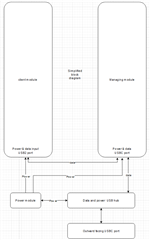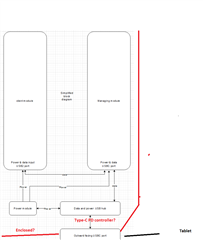Other Parts Discussed in Thread: TPS25751, HD3SS3212, TUSB8042A, TPS65983B
Tool/software:
Hi!
I'd like to get your input on a design problem we're facing, and see if TI has a solution which will work for us.
Our product is designed with 3 modules:
1. a tablet which uses a USBC port interface.
2. An client module which uses USB2 interfce (either USB2 plug or 4 cables- GND, VBUS, D- and D+ soldered to the relevant pads).
3. A battery and a battery manager to hold charge.
We'd like to allow the following:
1. Allow data to transfer between the client module and the tablet over USB.
2. Allow data to transfer between the tablet and an external PC, if one is connected.
3. Allow power to transfer from an external power supply (connected via USBC port) to the battery manager.
4. Allow power to transfer from the battery to the internal modules when no power supply is connected.
I'm providing a block diagram showing power and data paths between modules. The management module here is the tablet.
To do this, we need some 'Data and power' USB hub capable of allowing simultaneous data connection between the client module and the tablet, and a connection between the management module and the external PC.
It also needs to be capable of using USBC PD to draw as much W as the power supply is capable of giving, while outputing the relevant voltage to the tablet, the battery management system and the client module (5V).
Is there such a usb data-power hub in the TI portfolio?
Also, could you recommend a BMS for a 3.7 LI-ion battery which will work here?
Thanks


